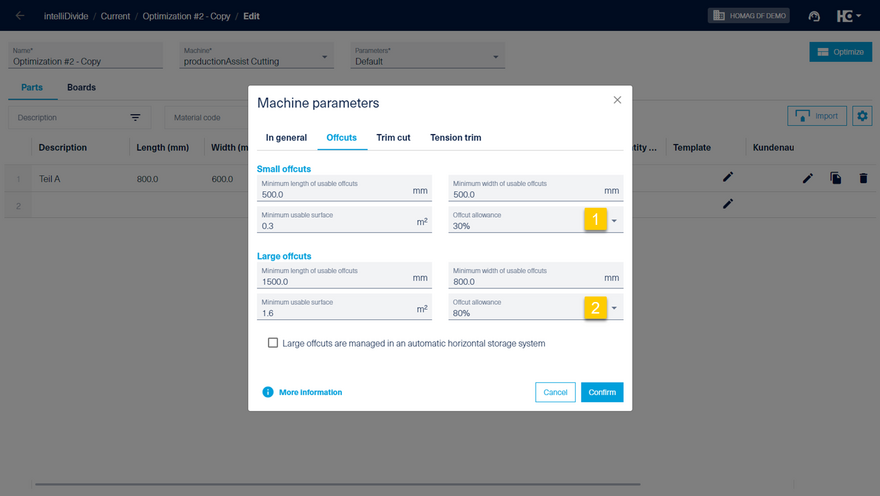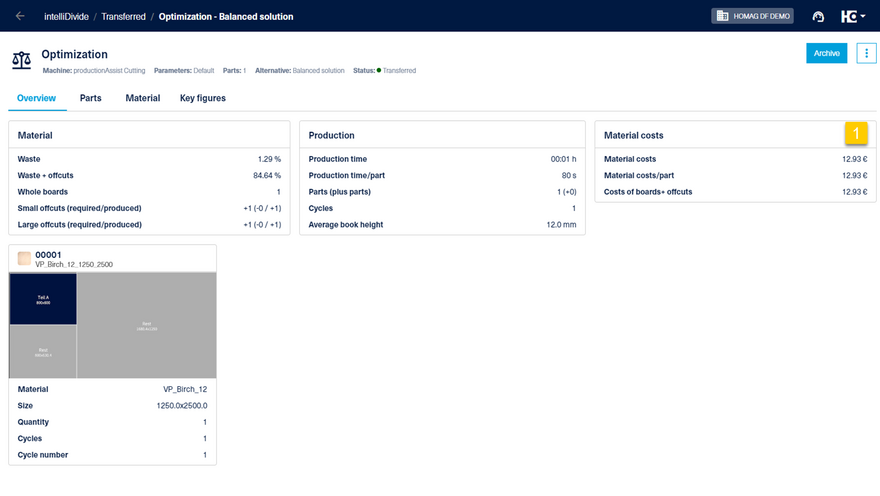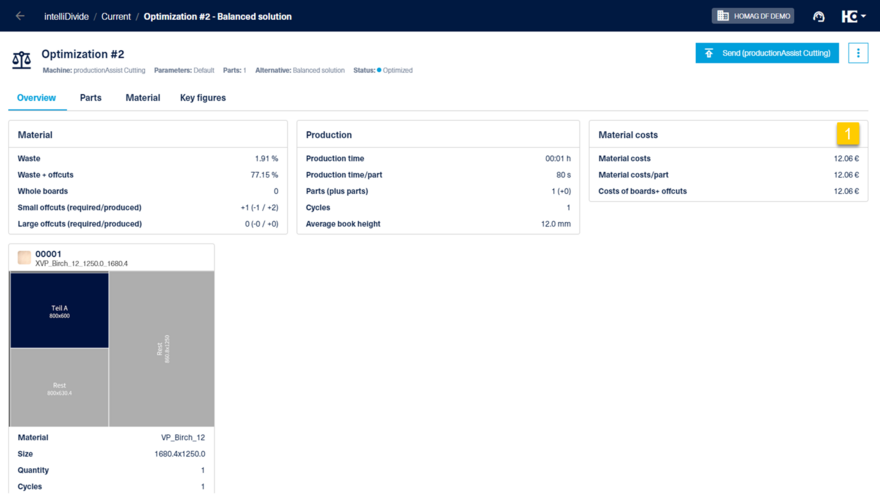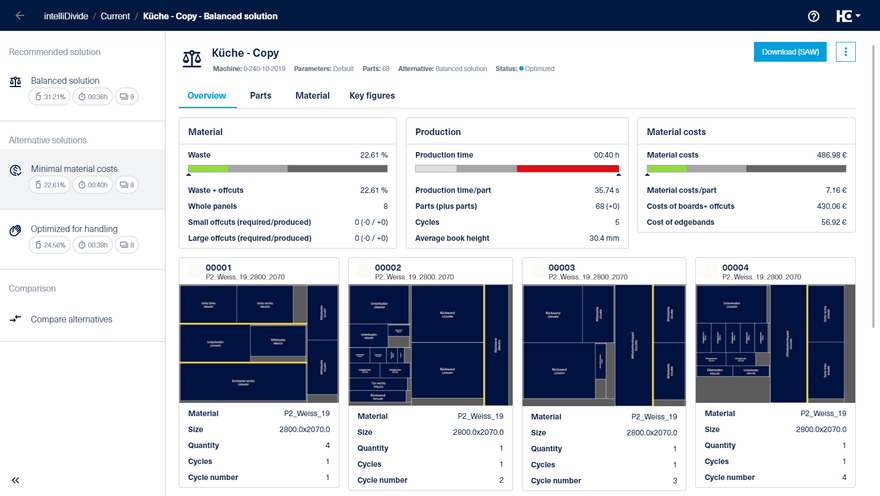Machine Parameters Cutting
For the correct calculation of cutting plans, a description of the machine to be used is necessary.
The settings can be adjusted in the machine parameters dialog.
The settings depend on the machine type.
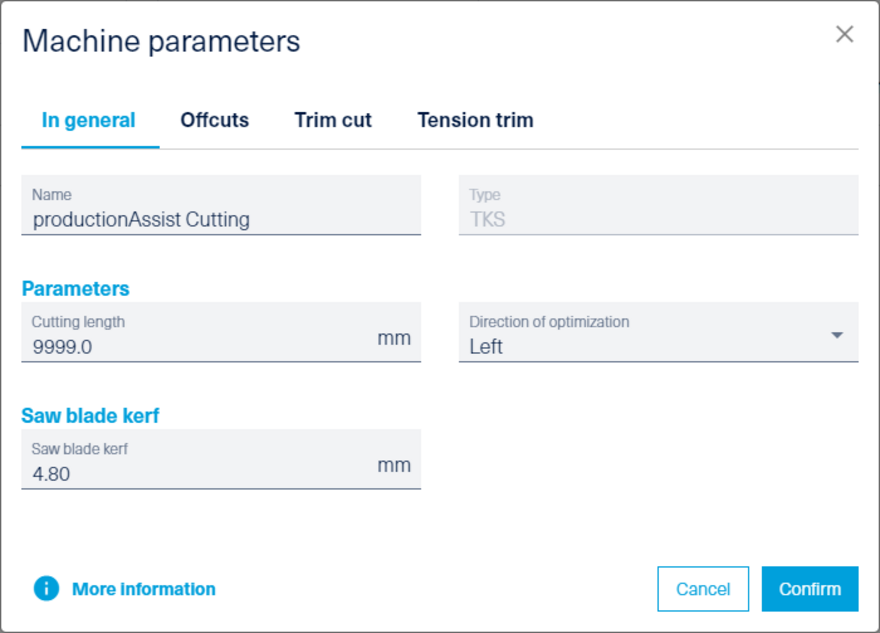
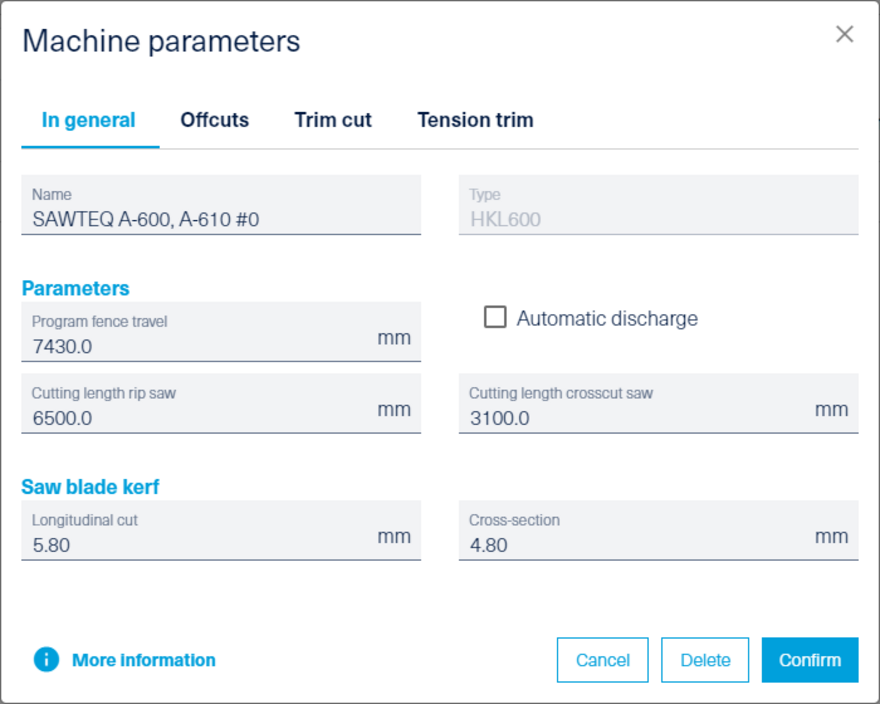
Parameters of a manual saw
Parameters of an angular saw
Furthermore, the settings depend on how the machine was added in intelliDivide.
For machines created directly in intelliDivide based on a template, a variety of parameters are displayed. For example, the cutting length and the program fence travel can be adjusted as required.
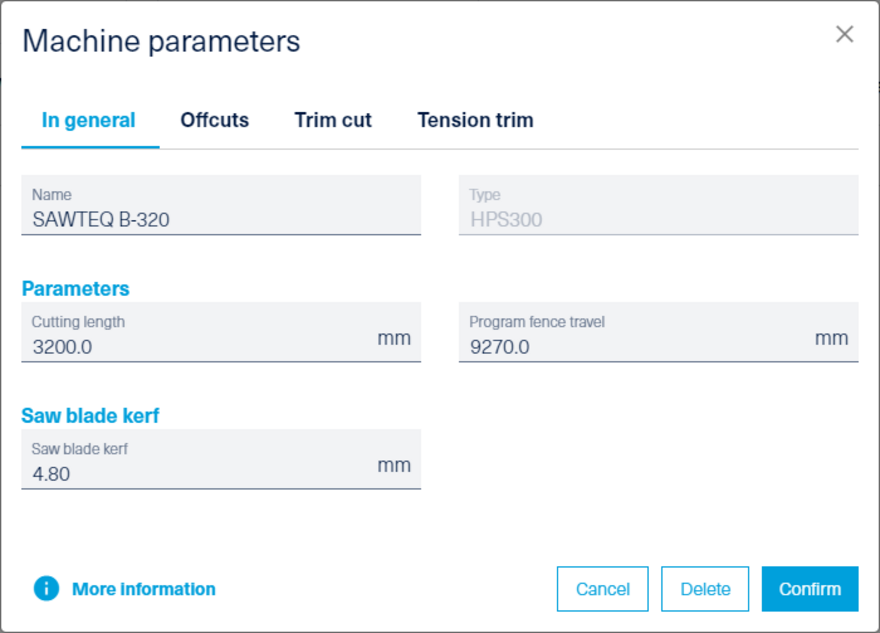
Machine parameters of a saw created based on a template.
For machines that were integrated via Tapio, the settings are taken directly from the machine. Fixed parameters are hidden for a better overview. Parameters that must be adjusted in some cases (e.g. saw blade thickness) are displayed. After deselecting the "Apply machine settings" option, these parameters can also be adjusted.
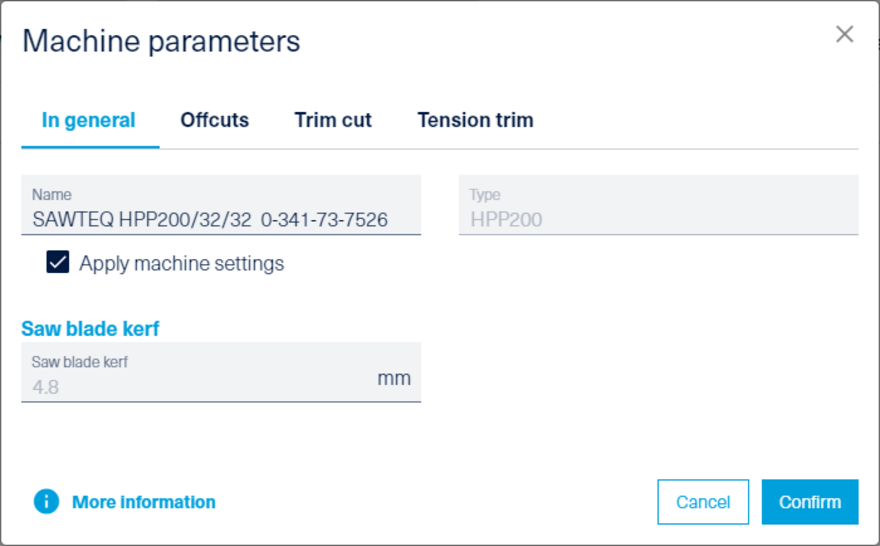
Machine parameters of a saw connected via tapio.
General parameters

General parameters
Valuation of offcuts
The minimum size of the offcuts and the offcut valuation have a very strong influence on the material costs. Since intelliDivide calculates alternative solutions and takes the material costs into account, the evaluation of the offcuts can influence how likely offcuts are to be reused.
If offcuts of a material are available and if they have a low valuation in relation to the costs, there is a high probability that one of the calculated solutions will preferentially use offcuts. The prerequisite is that the material costs have been created correctly in the materialManager.
A small offcut is valued at 30% of the material costs. The value is set at a very low level, as a great deal of effort is required for handling (printing a label, storage, retrieval, inventory) in relation to the material value. Furthermore, small offcuts are often difficult to reuse. Small offcuts should be avoided wherever possible and reused quickly.
In the example, a large offcut is valued at 80% of the material costs. The value of a large offcut is comparable to a board. The cost of handling is in good proportion to the material value. Nevertheless, these offcuts should also be avoided wherever possible and reused quickly.
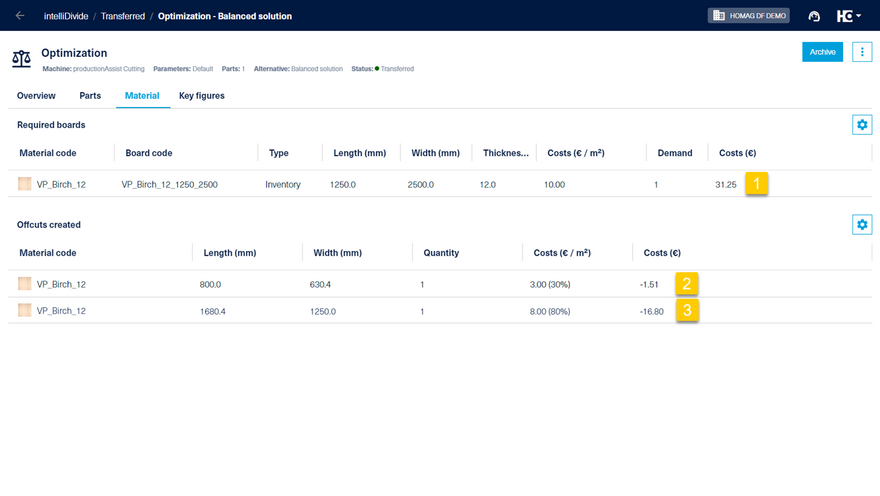
Overview of the cost of the board (1) and the evaluation of the offcuts produced after cutting (2&3).
The material costs are made up as follows:
One board is used for the optimization. Based on the costs of € 10 per m² and the size of 3.125 m², the costs are € 31.25 (1).
Two offcuts are created during panel dividing. A credit note is created according to the settings for the valuation of offcuts.
The small offcut (2) is valued at 30 %, i.e. € 3 / m². The offcut of around 0.5 m² thus has a value of € 1.51.
The large offcut (3) is valued at 80 %, i.e. € 8 / m². The 2.1 m² offcut therefore has a value of €16.80.
The material costs are therefore made up of the costs for the board €31.25 (1) and the credits for the small offcut €1.51 and the large offcut (3) €16.80. This results in material costs of €12.93.
The large offcut is subsequently reused in an order.
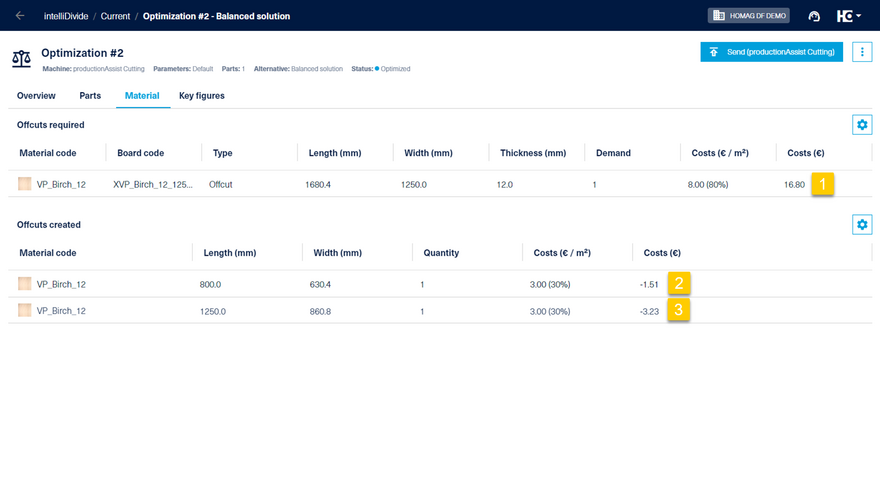
The material costs are made up of the costs for the board (1) and the credits for small (2) and large offcuts (3).
The imputed costs for the large offcut amount to € 16.80 (80% of € 10 / m² x 2.1 m²) based on the credit note from the previous order. There are two small offcuts, which are credited as before. The total material costs therefore amount to € 12.06.
Setting the minimum size of offcuts
Minimum size of offcuts: Offcuts corresponding to this size are managed in the manual offcut inventory. Smaller parts are treated as scrap.
Minimum size of large offcuts : Offcuts that correspond to this size are returned typical to the horizontal storage system.
Offcut allowance: The lower the value in the "Offcut allowance" field, the more likely it is that an offcut will be taken into account during the next optimization.

Setting the minimum size for offcuts
Setting the minimum trim cuts
Minimal trim: Depending on the panel quality, a trim is necessary to remove damage to the panels during transport and to ensure angularity.
Minimal trim for recut: Depending on the accuracy of the saw, a trim cut is necessary before and after recuts to ensure angularity.
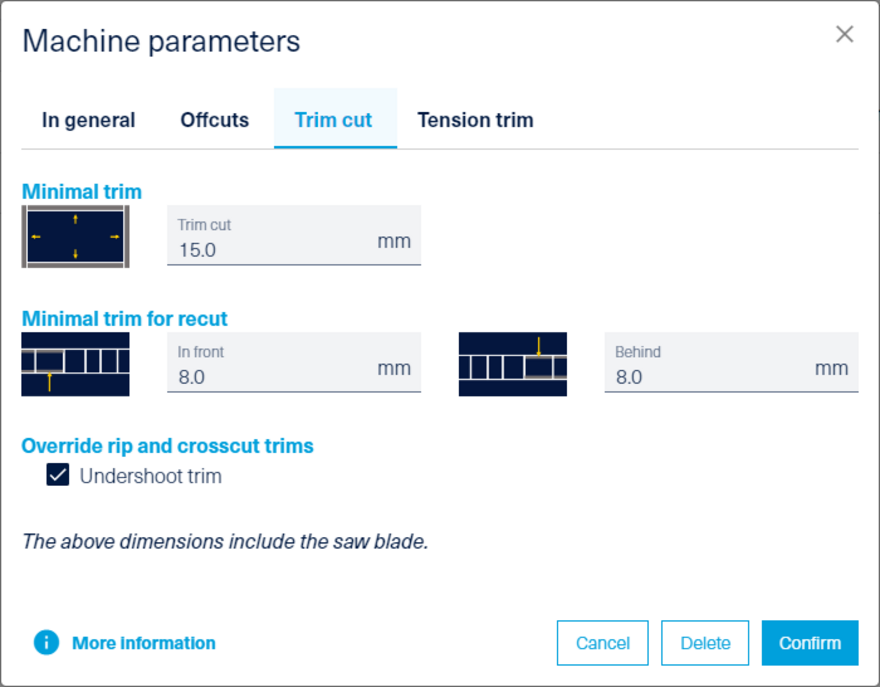
Setting the minimum trim cuts
Setting the tension trims
Due to storage and transport, e.g. from the outside to the inside, stresses can build up in boards as a result of temperature and humidity differences. These are released when the board is cut and thus lead to a reduction in the cut quality, dimensional accuracy and angularity of the cut parts.
To prevent this, intelliDivide supports the targeted insertion of tension cuts. These release the stresses and the so-called banana effect can be reduced or avoided. The subsequent final cut can then be executed with high accuracy.
Whether and how many tension trim cuts are necessary depends strongly on the quality of the boards, the environment and the quality requirement. Each tension trim involves an additional loss of material and time. The right balance must be found.
The following parameters are available to adjust the behavior:
Use tension trims: Activates or deactivates the insertion of tension trims.
Minimum cutting length: Stresses lead to dimensional accuracy problems, especially with long cuts. As a rule, tension trims are sufficient when cutting strips. The parameter can be used to define the length of a cut from which a tension cut is to be inserted. The smaller the value, the more tension trims are created.
Minimum distance: The parameter can be used to adjust the minimum distance between tension trims. If, for example, a strip is narrower than the entered value, a second tension trim is not inserted. The higher the value, the fewer tension trims are created.
The parameters are preset with values frequently used in practice.


